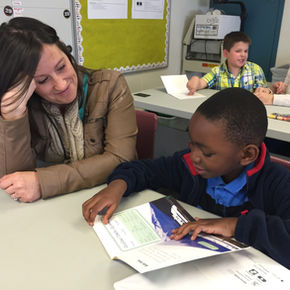Why We Exist
For far too long, New Mexico has been at or near the bottom of the list for child well-being and educational outcomes in the nation. [i] [ii] [iii] By no means do we want to deny or minimize this data, but we also know there is a lot that our communities have to offer. By implementing a community school strategy in public schools, we intentionally align resources, educational opportunities, out-of-school programming, and community needs and strengths into the educational experience.
The 2018 consolidated Yazzie/Martinez v. State of New Mexico lawsuit illuminated a critical need for improved student outcomes. In its ruling, the Supreme Court of New Mexico stated that certain students -- particularly Native American, English language-learning, low-income, and disabled students -- were not receiving their constitutionally guaranteed right of receiving a quality education by the state. [iv] At the time of this ruling, 75% of New Mexico students qualified for the national school lunch program, which subsidizes school meals, due to their families’ low income. [v] The community school strategy is an evidence-based intervention that has been proven to improve outcomes and increase opportunities for the categories of students who have been identified in this lawsuit. [vi]
Governor Michelle Lujan Grisham and the New Mexico State Legislature have seen the positive impact that community schools can have in our state and have prioritized and expanded opportunities for school districts and individual schools to bring the community school strategy to their community. [vii] As of the 2023-2024 school year, there are 91 community schools in New Mexico, with 77 of them existing in Albuquerque Public School District, [viii] with ABC Community School Partnership serving as the lead partner agency aligning the system-level resources and policies to further equip the democracy of the public schools by bringing in voice from students, teachers, business leaders, and the local community.
A community school is both a place and a set of partnerships between a school and other community resources. Its integrated focus on academics, services, supports, and opportunities leads to improved student learning, stronger families, and healthier communities. [ix]
References
[i] “2023 Kids Count Data Book.” The Annie E. Casey Foundation, June 14, 2023, https://www.aecf.org/resources/2023-kids-count-data-book
[ii] “2019 Kids Count Data Book.” The Annie E. Casey Foundation, June 16, 2019, https://www.aecf.org/resources/2019-kids-count-data-book
[iii] “2015 Kids Count Data Book.” The Annie E. Casey Foundation, July 21, 2015, https://www.aecf.org/resources/2015-kids-count-data-book
[iv] “Yazzie/Martinez v. State of New Mexico Decision.” New Mexico Center on Law and Poverty, Sept. 2018, http://nmpovertylaw.org/wp-content/uploads/2018/09/Graphic-Yazzie-Martinez-Decision.pdf
[v] “Indicator: Students participating in the national school lunch program in New Mexico.” The Annie E. Casey Foundation, Mar. 2019, https://datacenter.aecf.org/data/tables/6140-students-participating-in-the-national-school-lunch-program?loc=33&loct=2#detailed/2/any/false/1648,1603/any/12811
[vi] Maier, Anna, et al. “Community schools as an effective school improvement strategy: A review of the evidence.” Learning Policy Institute, Dec. 14, 2017, https://learningpolicyinstitute.org/product/community-schools-effective-school-improvement-report
[vii] New Mexico Legislature. Chapter 22, Article 32 NMSA 1978, Community Schools Act. New Mexico Compilation Commission, 2017, https://nmonesource.com/nmos/nmsa/en/item/4368/index.do#!b/a32
[viii] “NMPED Community Schools Award List.” New Mexico Public Education Department, June 5, 2023, https://webnew.ped.state.nm.us/bureaus/cs-and-elt/community-schools/grant/awards/
[ix] “Community Schools Playbook.” Partnership for the Future of Learning, n.d., https://communityschools.futureforlearning.org/






